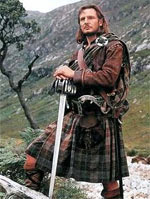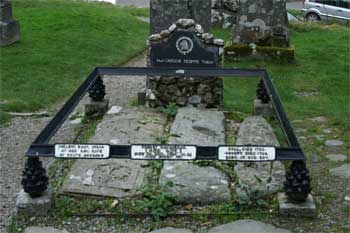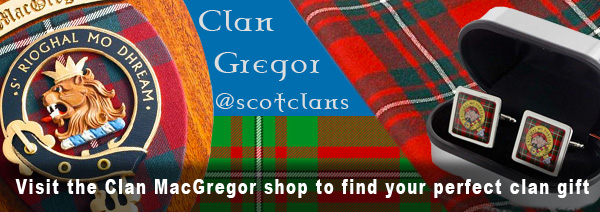
An old Clan feud has resurfaced after plans were announced that the remains of Rob Roy MacGregor were to be dug up. The legendary outlaw is believed to have been buried in Balquhidder, Stirlingshire. But the chief of Clan MacLaren now plans to exhume a body for DNA testing, proving once and for all if it is truely the Scottish folk hero. Donald MacLaren claimed Rob Roy really lies in an unmarked plot several miles away stating “MacGregor properganda lives on long and hard. It would be suprising if he was buried in what was a MacLaren kirkyard. I’m not hugely in favour of bus parties standing around looking at the grave and putting little posies on it. If he’s not there, this myth would stop.’

Rob Roy is thought to have been buried with his wife Mary and his two sons in 1734. Peter Lawrie, of the Clan Gregor society, called the move ‘desecration’, adding: “How would you feel if we suggested digging up the MacLaren graves? As far as we are conncerned, Rob Roy is buried in that grave.”


I think it is definitely Rob Roy in the grave. Why shouldn’t it be? Why on Earth would people claim it was his grave in the first place if it wasn’t? It is a very ordinary grave, quite easy to miss, in a very small churchyard in a tiny wee village in Scotland. I have visited on several occassions, and see no reason not to believe so. It is not well publicised, it is a very old grave off the main road by about 5 miles. Not exactly in a prominent position as though it were some money spinning scheme. And if you can imagine at the time of his life, the surrounding country side would be quite remote and wild and all the touristy bits wouldn’t have been there, so it isn’t beyond the imagination to think that he would have lived and died there and went to the church.
I am related to both the McLarens and the MacGregors. Which side am I supposed to take? I have been to the old churchyard at Balquidder and I agree with Lorraine’s analysis.
Hell, we might as well dig up a few others while we are at it aye? I mean WTH, we aren’t diggin up Elvis for DNA just because we see him everywhere!
Maybe they’ll find Jimmy Hoffa. 🙂
IF THERE IS A POSSIBILITY THAT IT IS NOT ROB ROY’S GRAVE IT NEED TO BE ESTABLISHED AS IT IS A MACLAREN GRAVEYARD
AND THE MACGREGORS WERE NOT THAT POPULAR I BELIEVE BECAUSE OF AN ON GOING FUED.
It is my hopes to help put to rest notions of an “ongoing” MacLaren/MacGregor feud at the time of his death that Robert Ruadh’s own bones may rest as easy.
Robert MacGregor was visited by John MacLaren on his deathbed, and whatever the discussions regarding who was rightfully the owner of the lands at Inverlochlarig Beg in 1734, MacGregor made his peace with John by giving him his sword. That sword was passed down that same MacLaren family line until a couple of generations ago, when it was secured by a family in Moidart. I am yet honoured to serve as temporary custodian of that sword further to refurbishing it.
It is true that Macgregor’s own sons, Robert Og, James and Ranald further fueled animosities and conflict between the two clans, though being of more fiery temper than their Father, their behaviour was not out of sorts with their characters. One of MacGregor’s sons wanted to try Ardshiel at the sword immediately after he had bested MacGregor in what was his last exchange of single combat, but MacGregor would not let him.
The fact that he had also made amends of a personal Nature on his deathbed with MacLaren would also not have stopped his Sons from rekindling that same issue, but the fact remains that MacGregor himself had made amends at that time.
May your bones rest as easy as your own sword does now MacGregor.
He shouldn’t even be in there…it’s a Maclaren graveyard !! I say get him out…if he’s even there
I was under the impression that since his status of “Outlaw” he would have been buried in an undisclosed location which has been done throughout history, you know that whole Martyr thing…
Is there any other proof that it’s him?
church or internment records?
Shouldn’t we ask ourselves, why a MacGregor would have been allowed to be interred in a MacLaren Kirkyard? Don’t you think the people who lived there at the time might have done something about it if it was an issue? Especially so, if there had been a feud going on?
I can defend the want of historical accuracy, that’s why people in the US keep digging up bodies purported to be Jesse James. There’s an intrigue associated with the legends of our past. Especially so with our outlaws I guess.
All year round, coaches and private cars bring visitors to view Rob Roy’s grave. Donald MacLaren in nearby Achleskine House is troubled by this attention to a MacGregor in what he considers to be a MacLaren glen. He has arranged to have erected close to the church, an information board which claims that Rob Roy is actually buried at Glengyle, or somewhere other than in ‘his Glen’.
The “Caledonian Mercury”` of 9th January 1735, reported the death of Rob Roy, “On Saturday was se’nnight died at Balquhidder in Perthshire the fam’d Highland partizan Rob Roy” (28/12/1734), the report did not actually state in so many words when and where he had been buried. As the 9th of January 1735 was Thursday, the previous Saturday was the 4th, and a week (se’nnight) before was the 28th of December. [8]
There are no parish records or other written reports of deaths in the parish during the 18th century, so the only physical evidence are the stone slabs over the grave, upon which no names have been inscribed. There are three carved stone slabs. The central slab was probably carved by a local mason for Rob Roy’s family – it bears a kilted figure, a sword and a tree – MacGregor symbols. John, a son of Coll, paid for a memorial in 1776 for his father bearing the MacGregor arms. That is the left hand slab.
Rob’s wife Mary and two of his sons are also commemorated as being buried in the grave. Rob’s sons, Coll and Ranald, were tacksmen (leaseholders) of the Kirkton farm and ran the inn, just a few yards away from the kirkyard, until Ranald’s death in 1786. Clearly they had significant status, probably greater than any MacLaren living in the area at the time.
Dorothy Wordsworth reported her visit to Glengyle and Balquhidder in “Recollections of a tour made in Scotland A.D. 1803”. She stated in Note 14 of her book that Rob Roy was buried at Balquhidder. Dorothy Wordsworth seems to have been somewhat gullible – she is responsible for the myth that Rob Roy had arms so long that he could tie his garters without stooping! A piece of Highland leg-pulling, no doubt. The small family burial enclosure at Glengyle House which was in use at the time of Rob’s death has no mention of him.
Sir Walter Scott in 1817 also stated in the introduction to his novel “Rob Roy” that he was buried at Balquhidder kirk. Scott wrote “This singular man died in bed in his own house, in the parish of Balquhidder. He was buried in the churchyard of the same parish, where his tombstone is only distinguished by a rude attempt at the figure of a broadsword.”
A page on the website graveyardsofscotland.com has “The claim that Balquhidder Kirk burial ground was the burying place of Clan MacLaren is another mis-representation which has been repeated so often it is taken in some quarters as fact.” The actual burial ground for MacLarens in the area is Leckine Cemetery, close to the fragmentary remains of the house of Ardveich at the southern end of Glen Beich where it joins Loch Earn. An old plan of the Leckine burial ground indicates that sections were set aside for the MacLarens in Glen Artney, in Auchraw, in Ardveich and Auchtow.
The webpage reports that it was exclusive to members of Clan MacLaren and the oldest burials are 17th century. It states “The Clan did not always bury their dead here. In fact, they were traditionally buried in Killin, a graveyard about ten miles away from Ardveich.”
Balquhidder Kirk was a burial ground for all people in the parish in the 18th century. MacLaren burials are relatively modern. The oldest graves recorded at the Balquidder Kirk are primarily MacGregors with Rob Roy’s listed as one of the oldest. The oldest MacLaren burial is fifty years later in 1788 with the rest being late 19th and 20th century. Totting up the currently extant memorial stones in the burial ground, there are 18 MacGregor dedications but only 15 MacLarens, which seems to contradict Donald’s assertion that it is a “MacLaren kirk”.
Donald MacLaren’s claims assume that the MacLarens in the glen were more important at the time than they actually were. Stewart’s book “Settlements in Western Perthshire” makes clear the relatively lowly status of the few MacLaren households in the 18th century.
A new book on the Clan MacLaren by Hilton Lamar McLaurin makes an interesting comment – “Donald MacLaren is one of the most active clan chiefs and represents by example what a modern Clan Chief’s role is. Unfortunately, modern scholarship has shown that his lineage is a fabrication based on a 19th century error. The 13th century Abbot Labhran, the founder of the clan never existed. Much of the clan’s history published by the Clan MacLaren Society is a fiction and a modern creation to transform a small clan in Perthshire with few followers into a large international Clan with sept names apparently carefully selected out of thin air.
An example of this created history is “Creag an Tuirc” the new motto and gathering place of the clan created in the 1950s. The traditional motto was Dalriada referring to the origin of the clan on the West coast of Scotland in Lorne, which is the actual source of the clan’s name, not a 13th century Abbot Labhran who never existed. MacLaurin goes on to prove that the true progenitor of Clan MacLaren was the Vicar Laurence at Ardchattan on Loch Etive.The “mhic Labhruinn” (pronounced VicLaurin” = MacLaurin) were recorded living in various places in Lorn in a document of 1463 and listed in the retinue of Dugald Stewart of Appin. Lord John Stewart of Lorn in 1473 married a MacLaurin woman from Ardveich on Loch Etive, Argyll, not from Ardveich on Loch Earn as claimed by the modern Clan MacLaren.
The historian, W F Skene, in 1837 misidentified MacLaurins in a 1467 list, but nothing in Skene’s account mentioned Balquhidder, Ardveich or Strathearn. James Logan in his 1845 work, “McIan’s Costumes of the Clans” compounded Skene’s error by confusing Ardveich in Appin, with Ardveich on Loch Earn.
The Earls of Argyll obtained authority over Balquhidder from the King in 1475, and over Appin in 1500. The Campbells were also superiors of the MacGregors. Thereafter the Campbells moved their dependants in, Malcolm Maklawryn with three sons, recorded at West Invernenty in 1512, was the first record in any document of a MacLaren in Balquhidde. Also at West Invernenty in the same document were MacGregors, also recorded for the first time in the parish. In 1544 and 1558, further MacGregor kin groups came, with violence, but all probably under the direction of the Campbells of Glen Orchy.
By the way, I am a Lawrie and have traced by own ancestry to the 17th century in Banff. My DNA is not MacLaren and I have not come across a Lawrie whose DNA does match the MacLarens. That’s another fiction!
Peter Lawrie
There is no sense in which any individuals ‘own’ a parish churchyard to exclude others that they don’t want buried there. The graveyard of a church belongs to the church which stands on it. What’s more individuals don’t ‘own’ churches – it is the Church of Scotland, and always has been that ‘owns’ a church and its associated graveyard. Only comparatively recently have local authorities assumed responsibility for the upkeep of graveyards. In the same way MacGregors can’t claim they ‘own’ the graveyard at Killichonan despite the fact that the largest proportion of burials there are of MacGregors. Peter is exactly right about the reasons for this confusion – and the fact that Wordsworth was initially misinformed that Rob Roy was buried in Glengyle was later corrected by him (which by the way is not what Donald McLaren maintains anyway). Also there is much more to Rob Roy’s story than that he was an ‘outlaw’ – the Duke of Montrose despised him, he took the wrong side in 1715 etc BUT he was pardoned by the King long before he died, so NOT an outlaw when he died.